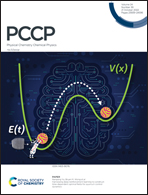Interface-engineering studies on the photoelectric properties and stability of the CsSnI3–SnS heterostructure†
Abstract
The stability of Sn-based perovskites has always been the main obstacle to their application. Interface engineering is a very effective method for improving the stability of perovskites and the efficiency of batteries. Two-dimensional (2D) monolayer SnS is selected as a surface-covering layer for the CsSnI3 lead-free perovskite. The structure, electronic properties, and stability of the CsSnI3–SnS heterostructure are studied using density functional theory. Due to the different contact interfaces (SnI2 and CsI interfaces) of CsSnI3, the interface electronic-transmission characteristics are inconsistent in the CsSnI3–SnS heterostructure. Because of the difference in work functions, electrons flow at the interface of the heterostructure, forming a built-in electric field. The heterostructures form a type-I energy-level arrangement. Under the action of an electric field in the CsI–SnS heterostructure, electrons at the CsI interface recombine with holes at the SnS interface; however, the holes of the SnI2 interface and the electrons of the SnS interface are easily recombined in the SnI2–SnS heterostructure. Moreover, monolayer SnS can enhance the light absorption of the CsSnI3–SnS heterostructure. Monolayer SnS can inhibit the migration of iodine ions and effectively improve the structural stability of the SnI2–SnS interface heterostructure. This work provides a new theoretical basis for improving the stability of lead-free perovskites.

- This article is part of the themed collection: 2022 PCCP HOT Articles


 Please wait while we load your content...
Please wait while we load your content...